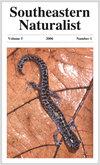不速之客:在佛罗里达州中北部使用人工筑巢地点识别独居蜜蜂和黄蜂的寄生虫和其他巢穴同伙
IF 0.4
4区 环境科学与生态学
Q4 BIODIVERSITY CONSERVATION
引用次数: 0
摘要
摘要-储存的食物和发育中的幼虫对寄生性节肢动物入侵者具有吸引力,它们利用了孤立膜翅目昆虫的工业。本研究收集并鉴定了为独居蜂和寄生蜂(膜翅目:寄生蜂科和寄生蜂科)设计和使用的人工巢址的节肢动物入侵者。我们连续3年每周收集从巢中出现的寄生节肢动物。我们绘制了侵染超过10个蜜蜂/黄蜂巢穴的每一种寄生虫的年筑巢和出苗率数据,并给出了每一种寄生虫的年/季节筑巢趋势。总共有265个节肢动物入侵,占蜜蜂或黄蜂建造的可存活巢穴的15% (n = 1765)。265个寄生蜂巢中,螨寄生6个(2.3%),蜂寄生14个(5.2%),甲虫寄生20个(7.5%),蝇寄生86个(32.5%),胡蜂寄生139个(52.4%)。这些结果为将来比较佛罗里达中北部隧道筑巢、独居蜜蜂和黄蜂的巢穴的寄生率提供了基线。本文章由计算机程序翻译,如有差异,请以英文原文为准。
Uninvited Guests: Identifying Parasites and Other Nest Associates of Solitary Bees and Wasps Using Artificial Nest Sites in North Central Florida
Abstract - Stored food and developing brood are attractive to parasitic arthropod invaders that exploit the industry of solitary hymenopterans. In this study, we collected and identified arthropod invaders of artificial nest sites designed for and used by solitary bees and wasps (Hymenoptera: Apoidea and Vespoidea). We collected parasitic arthropods emerging from the nests weekly for 3 years. We plotted annual nesting and emergence data for each species that invaded >10 bee/wasp nests and present the yearly/seasonal nesting trends for each parasite species. In total, arthropod invaders emerged from 265 or 15% of the viable bee- or wasp-constructed nests (n = 1765). Of the 265 parasitized nests, 6 (2.3%) were parasitized by mites, 14 (5.2%) were parasitized by bees, 20 (7.5%) were parasitized by beetles, 86 (32.5%) were parasitized by flies, and 139 (52.4%) were parasitized by wasps. These results provide a baseline for future comparisons of the parasitism rates of nests made by tunnel-nesting, solitary bees and wasps in north central Florida.
求助全文
通过发布文献求助,成功后即可免费获取论文全文。
去求助
来源期刊

Southeastern Naturalist
环境科学-生态学
CiteScore
1.20
自引率
16.70%
发文量
31
审稿时长
18-36 weeks
期刊介绍:
The Southeastern Naturalist covers all aspects of the natural history sciences of terrestrial, freshwater, and marine organisms and the environments of the southeastern portion of North America, roughly bounded from North Carolina south to Florida, west to Texas, north to Oklahoma, and east back to North Carolina. Manuscripts based on field studies outside of this region that provide information on species within this region may be considered at the Editor’s discretion.
 求助内容:
求助内容: 应助结果提醒方式:
应助结果提醒方式:


